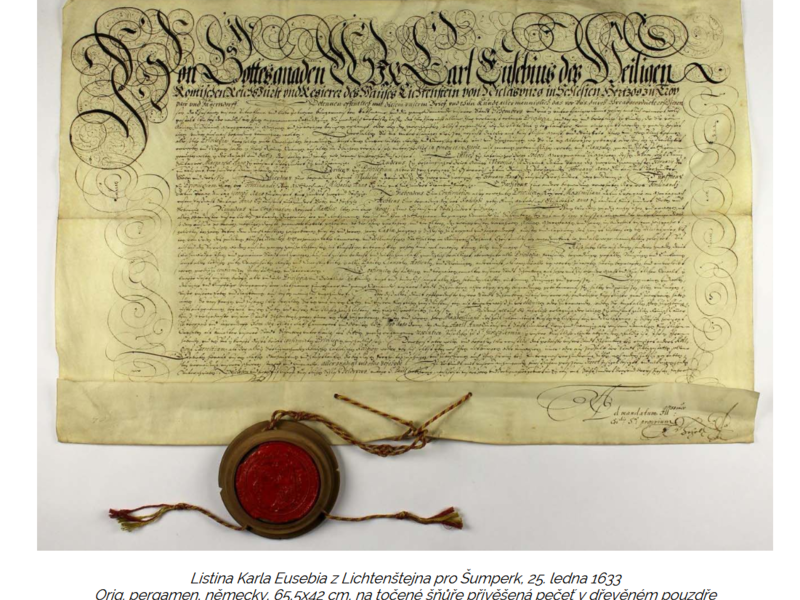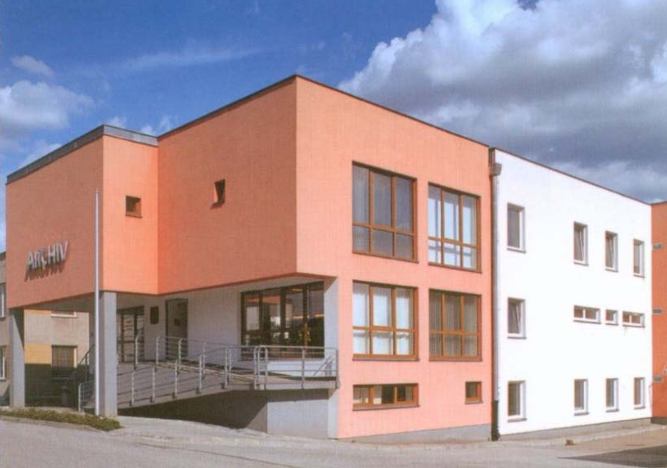Basic Features of the Archival Holdings on the History of the House of Liechtenstein
A number of towns and villages, which today fall within the jurisdiction of the Šumperk Regional State Archives, belonged to the House of Liechtenstein. We first encounter this noble family at the end of the 16th century, when Karl of Liechtenstein acquired the Úsov estate by marriage to Anna Černohorská of Boskovice after the Boskovice family died out. The further expansion of the family rule is linked to the previous mentioned founder of the Princely House, Charles I of Liechtenstein. During the time of the estates uprising, he loyally sided with Emperor Ferdinand II, for which he was rewarded with extensive estates, which were seized from the rebellious members of the Estates community. In 1622, he acquired the estates of Bludov [Blauda], Kolštejn [Goldenstein], Zábřež [Sabresch] and Ruda [Eisenberg], to which the estates of Šilperk ([Mährisch Schildberg] today's Štíty), Bohdíkov [Bohemian March Village], Bartoňov [Bartelsdorf] and Temenice [Hermesdorf]. The town of Šumperk suffered the same fate due to its participation in the estates uprising and lost the privilege granted by Emperor Ferdinand I in 1562, which declared it a town of the royal chamber, including other privileges and freedoms, and was entrusted to the care of Charles I of Liechtenstein; it remained under the administration of the princely family until 1848. From 1802, the House of Liechtenstein also owned Velké Losiny Castle. In 1945, the property was confiscated by Presidential Decree No. 12/1945 Coll.
The files of the properties (country properties) owned by the House of Liechtenstein can be found today in the Olomouc branch of the State Archives in Opava. The documents stored in the Šumperk District Archives, which are available to researchers, are mainly of an official nature; they are more or less individual items scattered mainly in the holdings of towns and municipalities that fell under Liechtenstein administration. The document of Alois Joseph of Liechtenstein from 1802, in which he confirms the earlier privileges of the village of Pusté Žibřidovice with regard to the work, bears witness to this. In addition to the relatively rich documentary material contained in the collections of the Staré Město Municipal Archives, the Šumperk Municipal Archives, the Zábřeh Municipal Archives and the collections of other municipalities (Branná [further Goldenstein], Pusté Žibřidovice, etc.), the State Archives also contain a number of other documents.), the State District Archive of Šumperk contains various correspondence (applications and complaints) addressed to Liechtenstein officials. Also worth mentioning are the numerous plans and sketches of the princely hunting grounds in the Šumperk-I District Office's holdings. There are practically no documents of a personal nature related to the Liechtensteiners in the Šumperk archives. The only exception are the memoirs of the Liechtenstein gardener Franz Slabý, written at the beginning of the 20th century, that record events from 1802; the memoirs are part of the historical documentation collection. Undoubtedly interesting is the record from 1880 of the exhumation and subsequent burial of the Lichtensteins from the archives of the Velké Losiny municipality. In the collections of the district and provincial committees there are documents containing information about the confiscation of Liechtenstein property in 1945.
Overview of Holdings Related to the House of Liechtenstein
Archive města Staré Město [Archive of the town of Moravian Old Town] 1437-1945 (1946)
Archive města Štíty [Archive of the town of Štíty (until 1949 Šilperk = Moravian Schildberg)] 1521-1945
Archive města Šumperk [Archive of the town of Moravian Šumperk ] (1402) 1419-1945 (1947)
Archive města Zábřeh [Archive of the town of Hohenstadt an der March] 1411-1945 (1967)
Archive obce Bludov [Blauda] 1565-1945 (1947)
Archive obce Branná [Archive of the village of Bord] /1560/-1945
Archive obce Úsov [Archive of the Municipality of Moravian Aussee] 1547-1945 (1946)
Okresní úřad Šumperk - I. [District Office of Moravian Schönberg ] (1786) 1850-1939 (1948)
Okresní úřad Zábřeh [District Office Hohenstadt an der March] (1726) 1850-1938 (1953)
Sbírka historicko-dokumentační [Historical-documentary collection] 1784-2004
Contact details
Státní okresní archiv Šumperk
Bratří Čapků 2684/3
787 01 Šumperk
Tel. +420 583 212 248
E- Mail:
https://www.archives.cz/web/soka/sumperk
Literature
Březina, Jan: Vlastivěda moravská II Místopis. Šumperský okres, Staroměstský okres, Vízmberský okres. [Local history of Moravia II. Local history. District of Moravian Schönberg. Old Town district. District of Wiesenberg]. Brno 1932.
Březina, Jan: Zábřežsko v období feudalismu do roku 1848 [The region of Moravia in the period of feudalism until 1848]. Ostrava 1963.
Hosák, Ladislav: Historický místopis země moravskoslezské [Historical local history of the Moravian-Silesian Region]. Praha 2004 (reprint 1. vyd. [(reprint of the 1st edition], Praha 1938).
Juřík, Pavel: Moravská dominia Liechtensteinů a Dietrischsteinů [Moravian dominions of the Liechtensteins and Dietrichsteins]. Prague 2009.
Metzler, Miloš - Schulz, Jindřich a kol. [et al.], Vlastivěda šumperského okresu [Local History of the Moravian Schönberg District]. Šumperk 1993.


